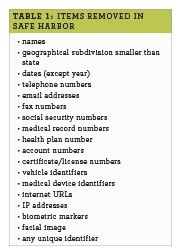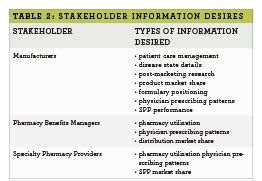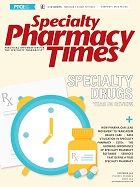Publication
Article
Specialty Pharmacy Times
Kind of a Big Deal: Data Utilization in Specialty Pharmacy
Author(s):
The pharmaceutical industry cherishes the diverse sets of feedback generated among parties operating in specialty pharmacy.
As a result of the near-universal conversion to electronic systems, society as a whole now generates data sets measured in terabytes of terabytes (petabytes). The development of personified supercomputers has been accompanied with marketing to herald the importance of big data.
This unfathomable volume of information touches nearly every facet of life on Earth—including specialty pharmacy. Although most of the buzz around big data surrounds pattern recognition in the plethora of collected data, the pharmaceutical industry cherishes the diverse feedback generated about all parties operating in this space.
Simply through the course of patient care, a specialty pharmacy provider (SPP) records innumerous amounts of data. This data captures valuable information regarding all stakeholders: manufacturers, third-party payers, physicians, patients, and even SPPs.
Big Scrub: De-identification of Data
Patient information collected in health care must be de-identified to protect patient confidentiality. While the government permits expert interpretation of the removal of protected health information (PHI), most firms opt to remove 18 items included in the Safe Harbor Method established by the Department of Health and Human Services (Table 1). Regardless of the method employed, any recipient of the remaining information must not be able to identify specific patients from the data set.

What remains after the data has been scrubbed is still immensely valuable, including clinical outcomes, prescriber data, and details from the claims adjudication and reimbursement process. Both pharmaceutical manufacturers and SPPs leverage this data in different ways to improve their operations.
Big Opportunity: Data Collectors
In response to the fierce demand for this de-identified data, several types of companies have emerged. Prior to the emergence of specialty therapies, data aggregators amassed massive amounts of information contained in electronic claims submissions. These companies, such as IMS Health and Wolters Kluwer, established the baseline for data to be sold to interested firms in the pharmaceutical industry.
This baseline information is obtained based off of NCPDP D.0 standard claims adjudication—including product, physician and reimbursement information—and is easily verified at the switch. However, as increasingly complicated and expensive specialty therapies continue to receive marketing approval, more detailed and robust feedback surrounding these products is desired.
SPPs have risen to meet this demand, building out data collection services in response to manufacturer demand for more specific info. In alignment with their high-touch services, SPPs are willing and able to customize data collection plans for a contracted manufacturer. This is a win-win situation: pharmaceutical companies are afforded any data they wish to collect and SPPs create an additional revenue stream for what is merely an extension of their standard business model.
Increasingly, SPPs are required to pass back this information through a manufacturer-commissioned HUB. While HUBs come in all shapes and sizes, the collection of data is the prime commonality of these companies. While a HUB can function as the exclusive distributor of a product, many are adjunctive to an open or limited specialty distribution network.
Regardless of the channel employed, SPPs can carve out a competitive advantage by maximizing their ability to capture data during the distribution of specialty products.
Big Appeal: Data Buyers
As mentioned above, stakeholders in the specialty pharmacy industry value big data in an atypical way. Valuing details over quantity, each stakeholder in the distribution channel covets information for different reasons—leveraging the insight derived from the data to obtain a competitive or financial advantage (Table 2).

All stakeholders in the distribution process value competitive industry data, as information such as market share assists executives with their strategic planning. Beyond these traditional metrics, pharmaceutical manufacturers are, far and away, the main consumers of these information products.
Since health care is a highly regulated industry, manufacturers are unable to solicit and obtain patient data as easily as your local grocery chain can. With barriers such as the Health Insurance Portability and Accessibility Act in place, drug companies are willing and able to pay handsomely to gain insight on the patients they serve.
This insight is applied to multiple aspects of a manufacturer’s business. Post-marketing surveillance, at times mandated by a REMS program, allows the company to understand how its product is used in the market. Knowledge of off-label prescribing can suggest opportunities for additional clinical research—allowing the firm to serve additional populations.
Patient copayment statistics shed light on the affordability of their product, and guide the creation of co-pay reduction cards and patient assistance programs.
The Pen is Mightier: Understanding Prescribing Habits
Despite their role as the end user of a drug product, patients are only part of the delivery dynamic. First, a provider must diagnose a patient with a treatable condition. Next, the prescriber selects a therapy to initiate in a patient from a litany of choices.
In competitive therapies, understanding which medications are favored by prescribers is coveted by both manufacturers and SPPs. Pharmaceutical companies leverage this understanding to identify heavy prescribers of their therapy, as well as providers who select competitive alternatives. Similarly, SPPs are able to discern which prescribers do not elect to consistently refer patients to their facilities.
In both situations, the prescribing data permits manufacturers and SPPs to market their services to individual prescribers in a more effective fashion. However, increasing the written prescription volume of a product, or for a specific SPP, is only half of the battle.
Big Gatekeeper: Data Regarding Pharmacy Benefit Managers
The cost of specialty therapies is often measured in thousands to hundreds of thousands of dollars per patient each year. This enormous financial burden generally requires assistance with funding. Clients from both the public and private sectors employ pharmacy benefit managers (PBMs) to implement cost-effective access to specialty drugs.
PBMs engage in contractual relationships with pharmacies and manufacturers in order to do business and leverage the competitive nature of the industry to drive down costs for these clients. Pharmaceutical companies can determine accurate market pricing of their product by purchasing de-aggregated claims data.
This financial information also guides the management of co-pay reduction and patient assistance programs, allowing the company to structure its programs to adequately impose the desired cost to the patient. After deconstructing the data, a manufacturer is able to outline its general place on a formulary and develop strategies to improve its product’s placement.
SPPs can contrast market fill information with the knowledge of the competitive networks in which they are eligible providers. This contrast illuminates the success and failures of the firm within their current network. In combination with the estimated costs of not participating in other networks, the management of a specialty pharmacy can more accurately and confidently plan the company’s growth.
Big Picture: Data is Important
Whether you are aware of how your company operates in the specialty pharmacy data subindustry or not, the implications are becoming increasingly meaningful to SPPs. Internal use of data varies from company to company, but access to the information permits self-evaluation of the firm’s standing in the marketplace.
Provided that the available information is accurately interpreted, SPPs can focus the company’s marketing strategically at underrepresented industry collaborators. The resulting improved relationships with these entities can be supplemented by establishing the company’s data collection abilities. Participation in some operations, such as NCPDP D.0 data aggregation, is necessary for simple credibility.
As a purveyor of data, the evaluation and improvement of operations must occur to maintain the ability to collect and package desired internal data. Functioning as both a collector and purchaser, an SPP solidifies its presence in this increasingly visible function within the industry.
Data as a revenue stream has grown significantly, and any SPP that excels in this space has a marked competitive advantage as information demands become more complex.
About the AuthorChristopher Ogurchak earned his PharmD degree from the Duquesne University in 2011. Ogurchak served as a pharmacy manager at an independent pharmacy in Southwestern Pennsylvania before transitioning to CVS Specialty Pharmacy as a clinical pharmacist. He is currently enrolled in the Master of Science in Pharmacy Business Administration (MSPBA) program at the University of Pittsburgh, a 12-month, executive-style graduate education program designed for working professionals striving to be tomorrow’s leaders in the business of medicines.







